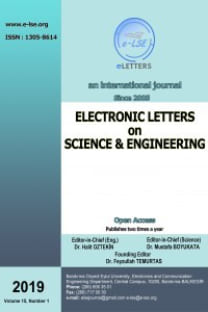Determination of crustal structure beneath the Çameli Basin (SW Turkey) using an aeromagnetic data
Determination of crustal structure beneath the Çameli Basin (SW Turkey) using an aeromagnetic data
The Çameli Basin, Magnetic Anomaly, the Reduction to Pole (RTP) the Upward Continuation, the Analytic Signal (AS).,
___
- [1] S. Över, S. Özden, A. Pınar, H. Yılmaz, Z. Kamacı, U.C. Ünlügenç, “Late Cenozoic stres state distributions at the intersection of the Hellenic and Cyprus arcs, SW Turkey,” J. Asian Earth Sci., vol. 132, pp. 94-102, Dec. 2016, doi:10.1016/j.jseaes.2016.10.003.
- [2] A.M.C. Şengör, “The North Anatolian transform fault:its age, ofset and tectonic significance,” J. Geol. Soc., vol. 136, pp. 269-282, June 1979, doi:10.1144/gsjgs.136.3.0269.
- [3] J.F. Dewey, A.M.C. Şengör, “Aegean and surrounding regions: complex multiplate and continuum tectonics in a convergent zone,” Geo. Soc. Amer. Bull., vol. 90, pp. 84-92, 1979, doi:10.1130/0016-7606(1979)90<84:AASRCM>2.0.CO;2.
- [4] A.M.C. Şengör and Y. Yılmaz, “Tethyan evolution of Turkey: a plate tectonic approach,” Tectonophysics vol. 75, pp. 181-241, June 1981, doi: 10.1016/0040-1951(81)90275-4.
- [5] X. Le Pichon and J. Angelier, “ The Hellenic arc and trench systems: a key to the neotectonic evolution of the eastern Mediterranean area,” Tectonophysics vol. 60, pp. 1-42, Nov. 1979, doi: 10.1016/0040-1951(79)90131-8.
- [6] J.F. Dewey, “Extensional collapse of orogens,” Tectonics vol. 7, pp. 1123-1139, Dec. 1988, doi:10.1029/TC007i006p01123.
- [7] G. Seyioğlu and B.C. Scott, “Late Cenozoic crustal extension and basin formation in west Turkey,” Geol. Mag., vol. 128, pp. 155-216, Mar 1991, doi: 10.1017/S0016756800018343.
- [8] A. Barka, “The North Anatolian fault zone,” Ann. Tecton. vol. 6, pp. 164-195, 1992.
- [9] S. Över, S. Özden, A. Pınar, H. Yılmaz, U.C. Ünlügenç, Z. Kamacı, “Late Cenozoic stres field in the Çameli Basin, SW Turkey,” Tectonophysics vol. 492, pp. 60-72, Sep. 2010, doi: 10.1016/j.tecto.2010.04.037.
- [10] J.H. ten Veen, S.J. Boulton, M.C. Alçiçek, “From palaeotectonics to neotectonics in the Neotethys realm: The importance of kinematic decoupling and inherited structural grain in SW Anatolia (Turkey),” Tectonophysics vol. 473, pp. 261-281, Jul. 2009, doi: 10.1016/j.tecto.2008.09.030.
- [11] M.C. Alçiçek, N. Kazancı, M. Özkul, “Multiple rifting pulses and sedimentation pattern in the Çameli Basin, southwestern Anatolia, Turkey,” J. Sed. Geo., vol, 173, pp. 409-431, Jan. 2005, doi:10.1016/j.sedgeo.2003.12.012.
- [12] R.Oberhansli, J. Partzsch, O. Candan, “First occurrence of Fe-Mg-carpholite documenting a high-pressure metamorphism in metasediments of the Lycian Nappes, SW Turkey,” In. J. Earth Sci., vol. 89, pp. 867-873, 2001, doi: 10.1007/s005310000103.
- [13] A. Ates, P. Kearey, S. Tufan, “New Gravity and Magnetic Maps of Turkey.” Geophys. J. Int., vol.136, pp.499-502, Feb. 1999, doi: 10.1046/j.1365-246X.1999.00732.x.
- [14] P.M. Paradisopouou, E.E. Papadimitriou, V.G. Karakostas, T.Taymaz, A. Killias, S.Yolsal, “Seismic hazard evaluation in western Turkey as revealed by stress transfer and time-dipendent probability calculations.” Pure Appl. Geophys., vol. 167, pp. 1013-1048, Aug. 2010, doi: 10.1007/s00024-010-0085-1.
- [15] E. Bingol, “Geological map of Turkey (Scale: 1/2.000.000),” General Directorate of Mineral Reaearch and Exploration (MTA), Ankara, 1989.
- [16] H. Alçiçek, F.P. Wesselingh, M.C. Alçiçek, G. Jimenez-Moreno, F.J. Feijen, L.W. van den Hoek Ostende, S. Mayda, A.S. Tesakov, “A multiproxy study of the early Pleistocene palaeoenvironmental and palaeoclimatic conditions of an anastomesed fluvial sequence from the Çameli Basin (SW Anatolia, Turkey),” Palaeogeogr. Palaeoclimatol. Palaeoecol., vol. 467, pp. 232-252, Feb. 2017, doi:10.1016/j.palaeo.2016.08.019.
- [17] M. Özkaptan, N. Kaymakçı, C.G. Langereis, E. Gülyüz, A.A. Özacar, B. Uzel, H. Sözbilir, “Age and kinematics of the Burdur Basin: Inferences for the existence of the Fethiye Burdur Fault zone in SW Anatolia (Turkey),” Tectonophysics vol. 744, pp. 256-274, Oct. 2018, doi: 10.1016/j.tecto.2018.07.009.
- [18] F.Akar and O. Özel, “Çameli bölgesi’nin 3-boyutlu gravite ve manyetik yapısı ve depremsellikle ilişkisi.” ÖHÜ Müh. Bilim. Derg., cilt. 7, sayfa. 1192-1197, 2018, doi: 10.28948/ngumuh.502440.
- [19] V. Baranov, “A new method for interpretation of aeromagnetic maps: Pseudo-gravimetric anomalies,” Geophysics vol.22, pp.359-383, Apr. 1957, doi: 10.1190/1.1438369.
- [20] V. Baranov and H. Naudy, “Numerical calculation of the Formula of reduction to the magnetic pole,” Geophysics vol. 29, pp. 67-79, Feb. 1964, doi: 10.1190/1.1439334.
- [21] R.J. Blakely, “Potential theory in gravity and magnetic applications,” Cambridge Univ. Press, Cambridge, U.K., 1995, pp.441.
- [22] R.G. Henderson and I. Zietz, “The upward continuation of anomalies in total magnetic intensity fields,” Geophysics vol. 14, pp. 517-534, Oct. 1949, doi: 10.1190/1.1437560.
- [23] W.R. Roest, J. Verhoef, M. Pilkington, “Magnetic interpretation using the 3D analytic signal,” Geophysics v. 57, pp. 116-125, Jan. 1992, doi: 10.1190/1.1443174.
- [24] R.T. Baldwin, R. Langel, “Tables and Maps of the DGRF 1985 and IGRF 1990,” IAGA Bulletin, ISGI Publications, France, vol. 54, pp. 103-185, 1993.
- [25] M.C. Alçiçek, S. Mayda, J.H. teen Veen, S.J. Boulton, T.A. Neubauer, H. Alçiçek, A.S. Tesakov, G. Saraç, H.Y. Hakyemez, F. Göktaş, A.M. Murray, V.V. Titov, G. Jimenez-Moreno, Y. Büyükmeriç, F.P. wesselingh, J.M. Bouchal, F.A. Demirel, T.T. Kaya, K. Halaçlar, M. Bilgin, L.W. van den Hoek Ostende, “Reconciling the stratigraphy and depositional history of the Lycian orogen-top basins, SW Anatolia,” Paleobiodiver. Paleoenviron., vol. 99, pp. 551-570, Dec. 2019, doi:10.1007/s12549-019-00394-3.
- [26] A. Ateş, F. Bilim, A. Büyüksaraç, A. Aydemir, Ö. Bektas, Y. Aslan, “Crustal structure of Turkey from aeromagnetic, gravity and deep seismic reflection data,” Surv. Geophys., vol. 33, pp. 869-885, Sep. 2012, doi: 10.1007/s10712-012-9195-x.
- [27] F. Bilim, “Investigation into the tectonic lineaments and thermal structure of Kutahya-Denizli region, Western Anatolia, from using aeromagnetic, gravity and seismological data,” Phys. Earth Planet. Inter., vol. 165, pp. 135-146, Dec. 2007, doi: 10.1016/j.pepi.2007.08.007.
- ISSN: 1305-8614
- Yayın Aralığı: Yılda 2 Sayı
- Başlangıç: 2005
- Yayıncı: Fevzullah TEMURTAŞ
İyileştirilmiş Kaotik Haritaya Dayalı Bir Dijital Görüntü Şifreleme Yöntemi
Determination of crustal structure beneath the Çameli Basin (SW Turkey) using an aeromagnetic data
Makine Öğrenmesi Sınıflandırma Algoritmaların Karşılaştırması: Metinden Dil Tanıma Örneği
Investigation of Industry 4.0 and Its Technologies
Meta-Sezgisel Optimizasyon Yöntemlerine Dayalı bir Rasyon Hazırlama Modeli
Yulaf ve Çavdar Unlu Bisküvilerde Bal Kabağı ve Şeker Pancarı Tozu İkamesinin Etkisi
